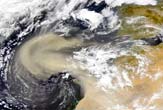
This story was updated at 12:49 p.m. EDT.
Westward swirling clouds of dust from the Sahara Desert might be putting a damper on Atlantic Ocean hurricanes, a new study suggests.
Researchers analyzing satellite data from the past 25 years found that during years when the dust storms rose up, fewer hurricanes swept across the Atlantic, while periods of low dust storm activity were followed by more intense hurricane activity. Hurricanes are fueled by heat and moisture, and it's thought the dust storms help muffle the storms before they fully develop.
By doing so, however, the dust storms could shift a hurricane's direction further to the west, the researchers say, increasing the likelihood that it would hit the United States and Caribbean Islands.
"These findings are important because they show that long-term changes in hurricanes may be related to many different factors," said study team member Jonathan Foley of the University of Wisconsin-Madison. "While a great deal of work has focused on the links between [hurricanes] and warming ocean temperatures, this research adds another piece to the puzzle."
The correlation between dust storms and hurricane activity are especially strong for the past few years, said study leader Amato Evan, also of the University of Wisconsin-Madison.
"In 2004, we saw an increase in dust activity and a decrease in hurricanes. In 2005, it was the exact opposite," Evan said in a telephone interview.
Sign up for the Live Science daily newsletter now
Get the world’s most fascinating discoveries delivered straight to your inbox.
2005 was the busiest hurricane season on record. It included 26 named storms and 13 hurricanes, including Katrina, hailed as the most destructive U.S. storm ever.
Preliminary analyses of this year's dust activity also support the theory, Evan said. The 2006 hurricane season has been weaker than originally forecasted, and Evan thinks the high dust storm activity observed earlier in the year is partly to thank.
"At the beginning of the year, we saw a lot of dust storms—just really continuous. Then, probably a few weeks ago, when we started seeing some of those hurricanes that were forming up in the Atlantic, we saw a real lack of dust activity," he told LiveScience.
The dust storms form when hot desert air from the Sahara collides with cooler, dryer air from the south to form winds that loft sand and dust into the atmosphere, where they are snared by strong trade winds and blown westward, across the Atlantic Ocean.
Some years, millions of tons of the fine tan-colored particles [image] form thick clouds that can traverse the oceans in as little as five days. But other years, for reasons still not understood, hardly any dust storms form at all.
Recently, Saharan dust storms have been implicated in everything from the spread of disease and epidemics to a harmless reddening of U.S. sunsets.
The study, performed in collaboration with the National Ocean and Atmospheric Administration (NOAA), is detailed in the Oct. 10 issue of Geophysical Research Letters.
- How & Where Hurricanes Form
- African Dust Storm May Redden U.S. Sunsets
- Sahara Desert Was Once Lush and Populated
- Bacteria & Fungi Ride Dust Across Oceans
- 2006 Hurricane Guide









